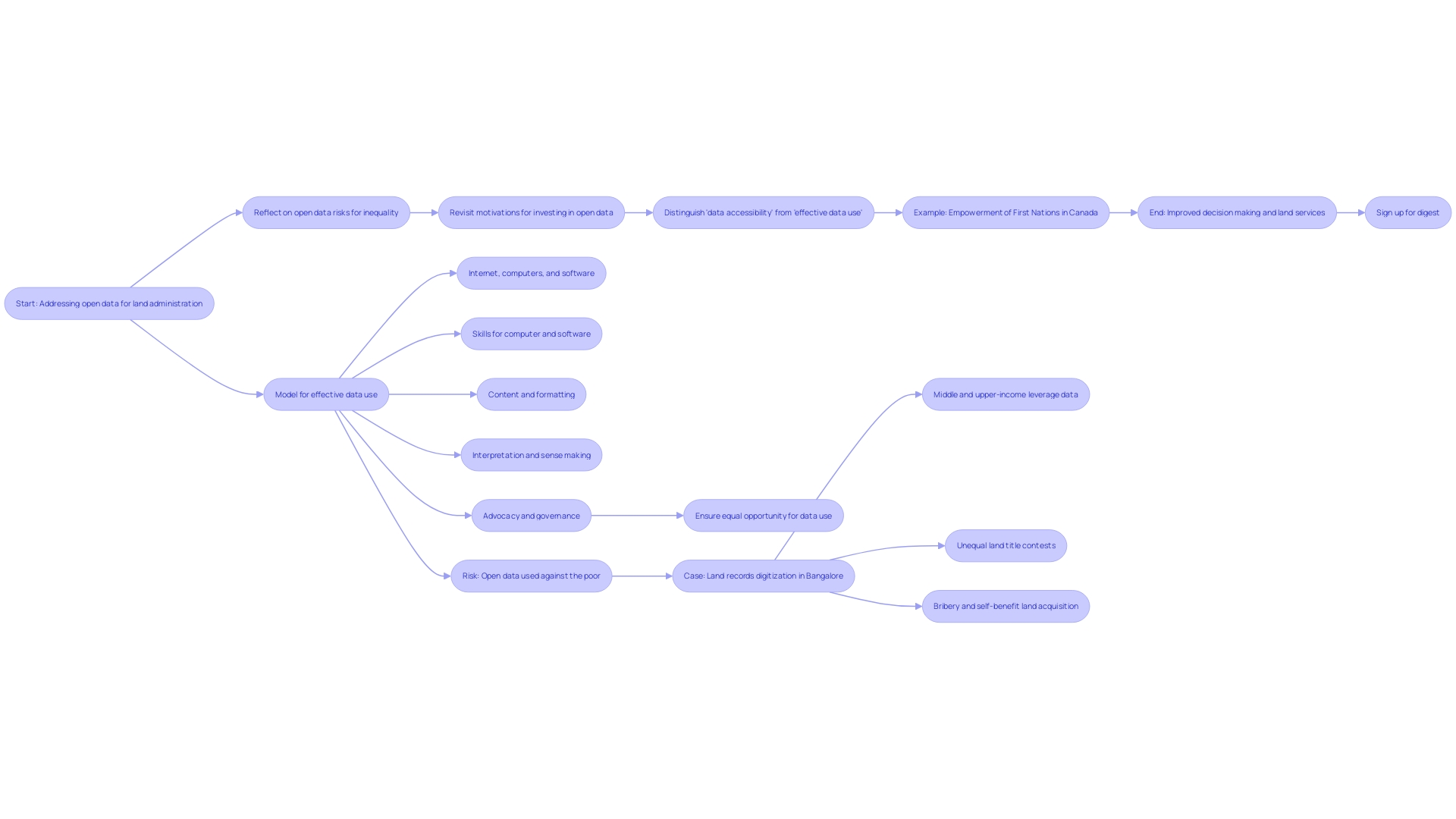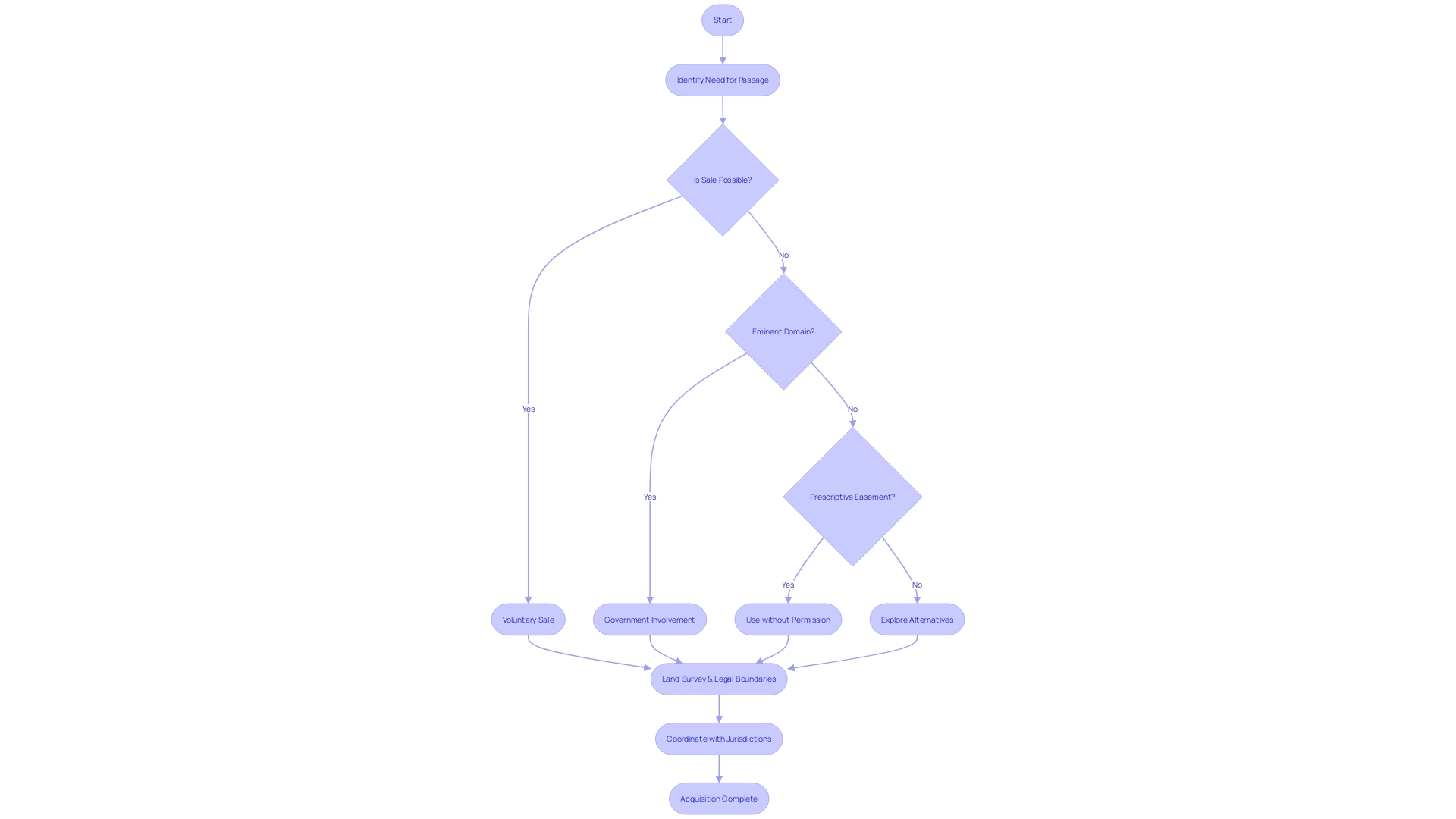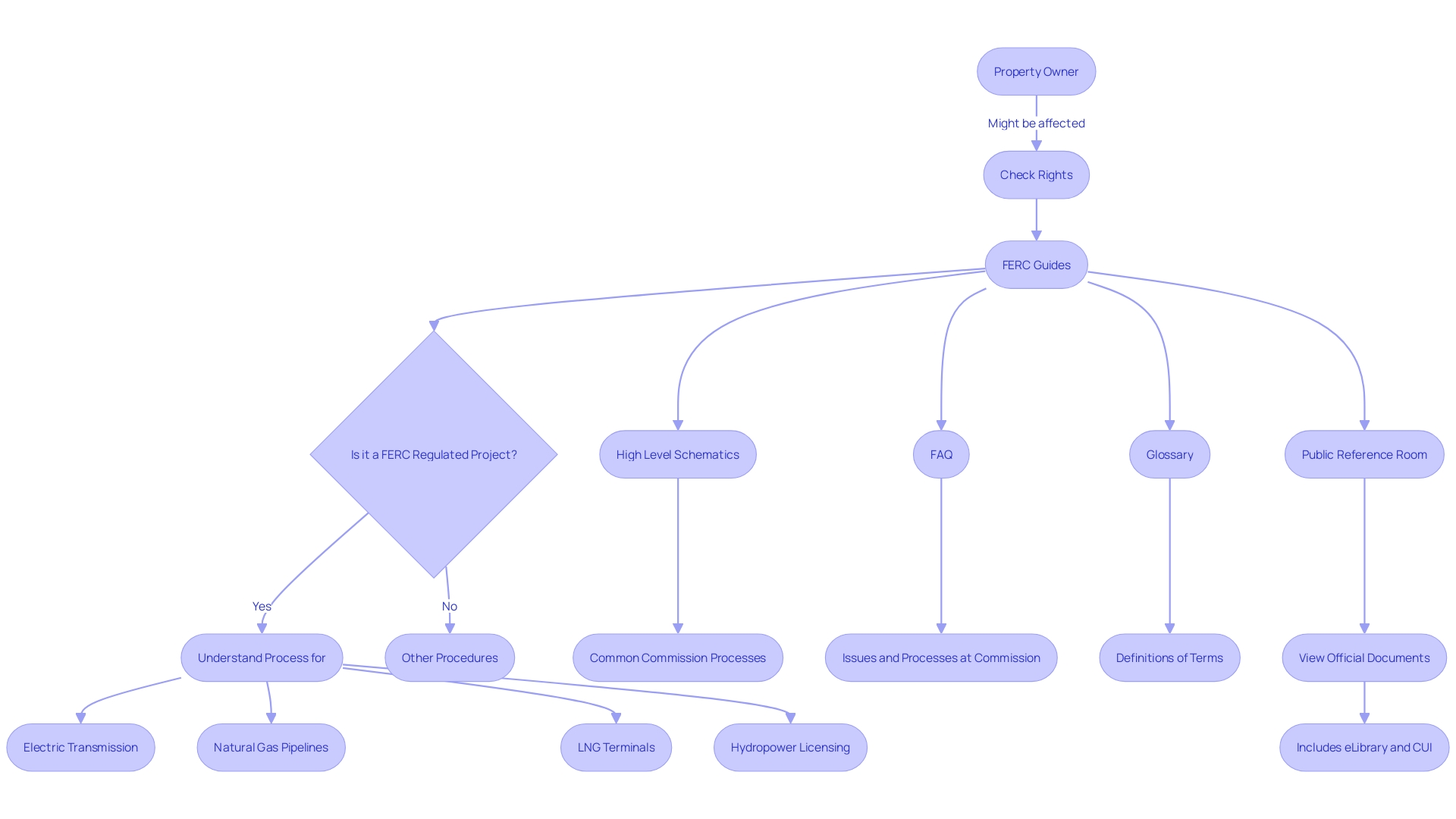Introduction
Rights of way on land refer to legal permissions allowing individuals to access or utilize a portion of another's property for specified uses. Understanding the nuances of right of way is critical for landowners to manage their property effectively and prevent legal disputes. In this article, we will explore the definition and types of right of way, the difference between right of way and easement, acquisition methods for right of way, the role of eminent domain in right of way acquisition, federal and state regulations governing right of way, key elements of a right-of-way agreement, steps to secure a right-of-way agreement, considerations for landowners in right of way agreements, compensation and relocation assistance for displaced property owners, and best practices for negotiating right of way agreements.
By delving into these topics, we aim to provide a comprehensive understanding of right of way and equip landowners with the knowledge they need to navigate the complexities of land rights.
Definition and Types of Right of Way
Rights of way on land refer to legal permissions allowing individuals to access or utilize a portion of another's land for specified uses. Comprehending the intricacies of way of ownership is crucial for landowners to oversee their property effectively and avoid legal disputes.
An easement of way is a common form, permitting the use of land for a particular purpose, such as utility line installation or access to a roadway. Landowners maintain ownership while granting restricted usage privileges to others. A notable case raising awareness of easement intricacies involved a farmer's objection to city expenditures exceeding $500,000 in an alleged attempt to appropriate land. The comprehension of individuals who own land emphasized the significance of being knowledgeable about easement agreements.
On the other hand, fee simple rights of way transfer full ownership of a section of land to another party for a specific purpose, giving up the original owner's privileges to that area. Legal dispute concerning this type of passage was apparent in the case where mineral privileges were debated. The court's decision emphasized the significance of thorough contract language to avoid future ownership disputes.
Recent advancements in technology, like GIS, have made it easier to handle data related to ownership, with platforms witnessing significant user participation, indicating the significance of these tools for landholders and experts in the domain.
As entitlements of passage are fundamental to property law, comprehending them from an exclusionary standpoint, as opposed to control, is crucial. This perspective regards the privilege of passage as the capacity to hinder others from utilizing a resource rather than the authority to utilize it oneself, as emphasized in legal literature.
The crossing of paths with community accessibility is also noteworthy. Organizations advocate for inclusive infrastructure, ensuring people of all abilities can navigate their environments, emphasizing the societal impact of such legal constructs.
To summarize, understanding easements is crucial for landowners, impacting land control, community access, and legal status. In this field, it is essential to stay updated and utilize technology to effectively navigate the intricacies of land issues.

Difference Between Right of Way and Easement
When talking about ownership privileges, it's essential to comprehend the differences between two significant ideas: passage entitlement and easement. An entitlement of passage is a legal permission allowing one to traverse someone else's land. It can arise through an agreement or be established by law, and may be granted for a specific duration or exist in perpetuity. Easements, on the other hand, are specific interests that allow the holder to utilize another's assets for a specific purpose, usually established through mutual agreement.
For example, consider a sidewalk adjacent to a street. Although frequently utilized by pedestrians, it is not simply a pathway but symbolizes a legal entitlement, differentiating it from the wider expression 'pedestrian way' and offering a tangible illustration of how such ownership privileges are enforced in everyday situations.
Moreover, ownership categories like freehold and leasehold have an effect on these ownership privileges. Freehold ownership implies full control over the land and territory indefinitely, enabling the owner to utilize the land as they deem appropriate, subject to local regulations. This is different from leasehold properties, where an individual possesses the premises for a specific period without entitlements to the land itself, frequently including ground rent or condominium fees.
To understand the intricacies of ownership, one must explore the intricate legal connections between individuals concerning things. As expressed in the book 'Legal Foundations of a Free Society,' ownership privileges are frequently comprehended as the entitlement to prohibit others from utilizing a resource rather than simply governing it. This viewpoint is crucial when contemplating privileges such as precedence, which inherently involves permitting certain uses while excluding others.
Statistics show that the application of these concepts is far-reaching, with technologies like GIS and databases playing a pivotal role in managing property-related information. For example, PogoData's success, demonstrated by substantial online engagement, is partly attributed to its extensive approach to integrating real estate data and legal frameworks.
Essentially, comprehending ownership privileges like access and permissions is crucial for individuals involved in land utilization and possession. These entitlements are firmly established in legal principles and are shaped by different factors, such as the nature of possession and the technological resources accessible to handle data related to assets.
Acquisition Methods for Right of Way
The acquisition of a privilege of passage over a parcel of land can occur through different paths, reflecting the complexity of property rights and the range of stakeholders involved. For example, a voluntary sale is often the most straightforward path, where an owner of the land willingly negotiates and consents to the sale of the right of way. In contrast, when a public need justifies it, the government may invoke eminent domain to secure land for projects like infrastructure expansion, providing fair market compensation to the landowner. Additionally, a prescriptive easement can emerge when an individual has used a portion of land openly and continuously without the owner's consent over a legally defined period.
In practice, the intricacies of these methods are highlighted by real-world scenarios. For example, enlisting the assistance of real estate experts can be extremely helpful when navigating the acquisition process, as observed in the situation of an individual seeking to buy an Akiya in Chiba Prefecture. This procedure included a thorough examination of numerous assets to discover a suitable option that satisfied the client's requirements, showcasing the carefulness essential in land transactions.
Furthermore, a land survey plays a pivotal role in defining property lines and dimensions, with qualified surveyors employing specialized tools to gather accurate data. This is crucial not only for establishing legal boundaries but also for preventing disputes and ensuring all parties are aware of their entitlements and limitations.
The necessity to comprehend and navigate laws concerning passage is further emphasized by the changing landscape of national infrastructure projects. For example, the transition to renewable energy sources in the United States is impeded by outdated infrastructure and the complex process of coordinating with multiple jurisdictions and landowners for the construction of large-scale transmission lines.
As policy evolves and projects expand, it becomes evident that proactive measures, such as early and strengthened engagement with local communities, can mitigate potential conflicts. This approach, coupled with a comprehensive understanding of land rights, is essential for facilitating the timely and efficient development of essential infrastructure.

Role of Eminent Domain in Right of Way Acquisition
Eminent domain, while often linked to the distressing idea of government seizure, is actually a legal mechanism ensuring private possessions are appropriated for public use while compensating the owner fairly. This procedure is not indicative of real estate conditionsâit does not imply a real estate is unsafe or uninhabitable. The exercise of eminent domain must satisfy four essential criteria: public use, just compensation, due process, and necessity.
The power to invoke eminent domain is rooted in the Fifth Amendment of the U.S. Constitution, granting this authority to federal, state, and local governments. Typically, the government will first attempt to purchase the property, and if an agreement cannot be reached, it may proceed to condemn the property through the courts. The recent bipartisan bill, House File 2522, exemplifies legislative efforts to provide property owners with a legal pathway to contest eminent domain use before any final decision by regulatory boards.
Case studies, such as the George brothers' situation in Brentwood, Missouri, where their family property—a hallmark of their heritage—faces the threat of eminent domain, underscore the profound personal impact beyond mere financial compensation. Similarly, Raphael Augustine's predicament in Douglas County, where his investment in a home for his mother-in-law is jeopardized by a looming eminent domain action without a clear compensation offer, highlights the contentious nature of such proceedings.
It is crucial for landowners to be knowledgeable about the intricacies of eminent domain laws and to comprehend their entitlements. This knowledge is crucial when faced with the potential acquisition of their property, ensuring they are prepared for legal processes that may unfold.

Federal and State Regulations Governing Right of Way
Understanding the intricate network of way of laws necessitates a clear comprehension of both federal and state regulations. Federal agencies such as the Federal Highway Administration (FHWA) and the Federal Energy Regulatory Commission (FERC) set forth policies governing the acquisition of land for transport and energy projects. These organizations offer materials, such as guidebooks and detailed process diagrams, to educate property owners about their entitlements and the acquisition method. For example, FERC provides a toll-free helpline and email support to assist individuals who may be impacted by natural gas or hydroelectric projects, ensuring they are well-informed throughout the process.
State laws, while varying across jurisdictions, establish formal procedures for acquisition of way. These typically include steps for negotiation, fair compensation, and mechanisms for resolving disputes. It's also worth noting that recent news, such as the City of Chicago's lawsuit against major oil companies, highlights the evolving legal landscape and the potential impact of environmental considerations on infrastructure projects. The FAST-41 legislation further underscores the range of sectors that may be affected by federal authorization or environmental reviews, from renewable energy to broadband and artificial intelligence.
Considering this context, it is crucial for property owners to remain knowledgeable about the particular regulations relevant in their region. Through the utilization of the accessible resources, like FERC's public reference room and eLibrary, individuals who possess property can gain a deeper comprehension of the complexities of way laws and effectively safeguard their concerns.

Key Elements of a Right-of-Way Agreement
Understanding the complexities of right-of-way agreements is crucial for individuals who own land, as these documents establish the terms under which others can utilize their property. Such an agreement must specify the individuals involved, providing clear understanding of the responsibilities of both the property owner and the entity granted the privilege of passage. The documentation should also include a comprehensive description of the right-of-way area, pinpointing its exact location, dimensions, and designated purpose, much like a detailed PPA delineates the scope of a development project.
The agreement's lifespan, whether temporary or in perpetuity, must be explicitly stated to avoid any future disputes. Maintenance obligations, a common source of contention as seen in the wildfire risk management in California, should be clearly divided, ensuring both parties understand their respective duties. Financial compensation for the landowner, a topic of great interest in agreements like Salem's recent CBA with Crowley, is another essential element that must be addressed with specificity to prevent undervaluation of the landowner's entitlements.
Lastly, the conditions under which the privilege of passage may be terminated or expire should be included within the agreement. This ensures that all parties are aware of the circumstances that could lead to the cessation of the privilege of way, similar to how development agreements account for regulatory changes and provide protections against them. To ensure comprehensive safeguarding of their interests, individuals who own land are recommended to consult legal professionals, similar to the comprehensive planning discussions that occur between real estate developers and local authorities for mutually advantageous development contracts.
Steps to Secure a Right-of-Way Agreement
To effectively secure a right-of-way agreement, a landowner must undertake a series of critical steps:
- Determine the necessity: Determine the specific reasons for requiring a way of passage and its anticipated advantages for the requesting entity.
- Carry out investigation: Gather comprehensive data concerning the land, including any pre-existing privileges of passage or easements that could impact the proposed access route.
- Consult with Professionals: Obtain guidance from attorneys and land service consultants with expertise in right-of-way acquisitions.
- Negotiate Terms: Discuss and agree upon the conditions of the right-of-way agreement with the requesting party.
- Review and Sign: Meticulously examine the proposed agreement and seek legal counsel before finalizing it.
- Record the Agreement: Ensure that the agreement is officially recorded with the relevant government body, establishing its lawful standing.
This organized method helps individuals who own land in efficiently overseeing the acquisition procedure while protecting their privileges and concerns. For example, in the context of heightened wildfire risks in California, utilities have faced significant scrutiny and reputational challenges. The thorough comprehension of risks and meticulous negotiation strategies are vital, similar to how energy companies must negotiate with individuals who own land when securing land for hydraulic fracturing, as described in a Nature Energy paper. Furthermore, cities like Plano, Texas, demonstrate the importance of modern practices and informed decision-making, as they tackle large-scale projects like updating their water systems to meet new regulations. Such real-world cases underscore the importance of a strategic, well-informed approach to right-of-way agreements to ensure benefits for all parties involved.
Considerations for Landowners in Right of Way Agreements
Navigating right-of-way agreements requires in-depth understanding and strategic foresight. Landowners must assess the potential impact on the value of their land, recognizing that the easement could influence both current and future valuations. It's critical to clarify maintenance obligations within the agreement to avoid unforeseen expenses. Additionally, property owners should consider the consequences of the access passage on any potential growth strategies, guaranteeing that their aspiration for the future of the land remains attainable.
Compensation is another crucial element; individuals who own the land must carefully examine the offer to ensure that it represents fair and adequate compensation for the granted access. Legal counsel is essential in this process, offering expertise to protect the landholder's privileges and concerns.
Real-world cases illustrate these considerations. For instance, the centerline presumption—an approach that assigns ownership of land to the middle of an adjacent right-of-way—highlights the complexity of such agreements. This assumption aims to avoid conflicts over small parcels of land and can apply to mineral interests, as demonstrated by a Colorado Supreme Court case involving land owners and a developer competing for drilling royalties.
Complexities arise when the developer retains ownership of one out of many lots, potentially altering the dynamics of right-of-way ownership. Such nuances underscore the necessity for landowners to thoroughly analyze and negotiate the terms of right-of-way agreements.
In a different scenario, individuals questioned the city's spending on acquiring assets, underscoring the significance of understanding real estate laws and asserting one's entitlements. These examples demonstrate the complex interaction between ownership privileges, development strategies, and legal requirements in negotiations regarding the passage.
As the real estate market evolves, development agreements emerge as a tool to navigate uncertainty, allowing for a balance between public benefits and private interests. These agreements can offer protection against regulatory changes, ensuring the longevity and success of development projects.
To exemplify, PogoData's experience with technological advancements, such as GIS and programming languages, attests to the wider framework in which property owners and developers operate. The platform's substantial user engagement, with over 21,000 hits a month, demonstrates the importance of current information and educational prospects in the domain of real estate development and entitlement management.
In the end, it is by making well-informed decisions, engaging in strategic planning, and practicing legal diligence that landowners can effectively manage right-of-way agreements and safeguard the worth and potential of their assets.
Compensation and Relocation Assistance for Displaced Property Owners
When a right of way results in the need to displace owners, it's critical to understand the implications and support available, including financial compensation and relocation assistance. Owners have the right to receive just compensation for their assets, determined by the market worth, taking into account any harm caused by the acquisition and other associated expenses. In cases of necessary displacement, owners may be eligible for relocation assistance. This aid can include financial assistance for relocation costs as well as support in finding a new place.
The complexities of these situations are illustrated by various case studies. For instance, in the Chiba Prefecture of Japan, a customer involved with a consulting company paid ¥220,000 to start the exploration for rural real estate, indicating the significant financial commitment involved in acquiring and relocating. Similarly, the Israel Lands Authority's evacuation of an illegal squatter's camp to make way for Highway 6 involved lengthy negotiations and substantial compensation for the displaced parties.
In Toronto, small businesses facing expropriation due to the Ontario Line were reassured by Metrolinx that they would not suffer financial loss, highlighting the importance of fair treatment in the acquisition process. These practical illustrations emphasize the need for property owners to be knowledgeable about their entitlements and to seek expert legal guidance to guarantee fair remuneration and support throughout the procurement and relocation procedure.
Best Practices for Negotiating Right of Way Agreements
When negotiating an agreement for passage, it's crucial to approach the process with diligence and a strategic mindset. Here are some refined strategies to ensure a fair and effective negotiation:
- Seek Expertise: Enlist legal professionals and land services consultants with a track record in right of way issues. Their specialized knowledge will be crucial in safeguarding your interests. Gain a thorough understanding of the laws and regulations that govern the way in your area. Knowledge is power when it comes to legal negotiations.
- Thorough Investigation: Gather and evaluate information concerning the proposed path, assessing its effect on your property and establishing a standard for compensation based on previous instances.
- Detail Terms: Ensure that the of way agreement's terms and conditions are explicitly outlined, leaving no room for ambiguity.
- Open to Compromise: Enter negotiations with flexibility, aiming for a win-win outcome that serves both parties' interests.
- Careful Examination: Prior to accepting any conditions, thoroughly assess the suggested agreement with your legal advisor to guarantee that your entitlements are completely safeguarded.
By integrating these practices into your negotiation strategy, you can confidently navigate the intricacies of right of way agreements, ensuring that your property and financial interests are adequately defended.
Conclusion
In conclusion, this article provided a comprehensive understanding of right of way, covering topics such as the definition and types of right of way, the difference between right of way and easement, acquisition methods, the role of eminent domain, federal and state regulations, key elements of a right-of-way agreement, steps to secure an agreement, considerations for landowners, compensation and relocation assistance, and best practices for negotiation.
Understanding right of way is crucial for landowners to effectively manage their property rights and prevent legal disputes. It is important to differentiate between right of way and easement, as they have distinct legal implications.
Acquiring a right of way can occur through voluntary sale, eminent domain, or the establishment of a prescriptive easement. Landowners should seek professional guidance during the acquisition process to ensure their rights are protected.
Eminent domain, while often associated with government seizure, is a lawful mechanism that ensures fair compensation when private property is appropriated for public use. Landowners need to be aware of the criteria and their rights in such situations.
Navigating right of way laws requires understanding federal and state regulations. Federal agencies like the Federal Highway Administration and the Federal Energy Regulatory Commission set policies, while state laws establish formal procedures. Staying informed about specific regulations in their area is essential for landowners.
Securing a right-of-way agreement involves critical steps such as identifying the need, conducting research, consulting professionals, negotiating terms, reviewing and signing the agreement, and recording it. Landowners must approach this process with diligence and seek legal advice to protect their rights.
Considerations in right of way agreements include the impact on property value, maintenance obligations, and implications for future development plans. Landowners should carefully negotiate terms and seek legal counsel to ensure their interests are adequately protected.
When a right of way displaces property owners, fair compensation and relocation assistance are crucial. Property owners have the right to receive just compensation based on market value and may be eligible for additional support during the relocation process.
Negotiating a right of way agreement requires a strategic approach, seeking expertise, gaining legal literacy, conducting comprehensive research, detailing terms, being open to compromise, and reviewing agreements with legal counsel.
In summary, understanding right of way is fundamental for landowners to navigate the complexities of property rights. By following best practices, seeking professional guidance, and staying informed about the relevant laws and regulations, landowners can effectively manage right of way agreements and protect their property's value and potential.




